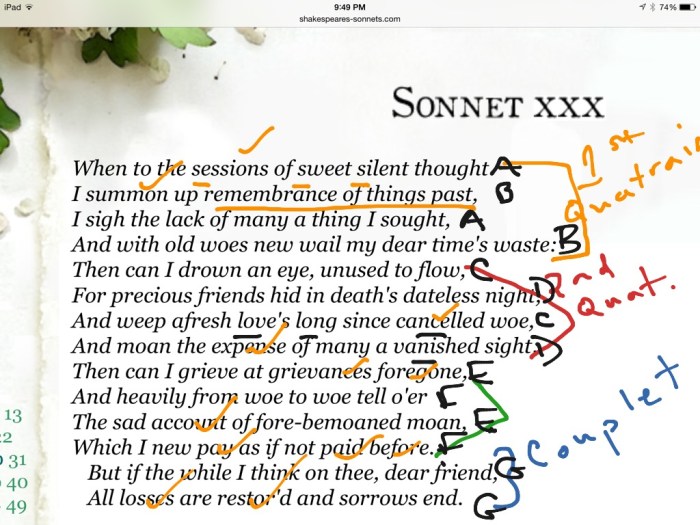Erin is writing about the history of sonnets – Erin’s writing on the history of sonnets embarks on an enlightening journey through the evolution of this beloved literary genre. From its origins in the vibrant courts of Italy and France to its profound impact on English literature, this exploration delves into the sonnet’s enduring legacy and its captivating ability to express a vast spectrum of human emotions and ideas.
In the tapestry of literary history, the sonnet stands as a testament to the power of language, showcasing the artistry of renowned sonneteers such as William Shakespeare, John Donne, and Elizabeth Barrett Browning. Through an in-depth analysis of their works, Erin unravels the intricacies of sonnet form, revealing the ways in which these poets employed its structure to convey complex themes and evoke profound emotions.
The Origins of Sonnets

The origins of sonnets can be traced back to the Italian and French poetry of the 13th and 14th centuries. The Italian sonnet, known as the Petrarchan sonnet after the poet Petrarch, consisted of 14 lines divided into an octave (eight lines) and a sestet (six lines).
The octave typically presented a problem or question, while the sestet offered a resolution or answer.
The French sonnet, known as the rondeau, was also 14 lines long but had a different rhyme scheme and structure. The rondeau typically consisted of three stanzas of five, three, and four lines, with the first and second lines of the first stanza repeated as a refrain at the end of the second and third stanzas.
Structure and Form of Early Sonnets
Early sonnets were typically written in iambic pentameter, a poetic meter consisting of five pairs of unstressed and stressed syllables. The rhyme scheme of the Petrarchan sonnet was ABBA ABBA CDCDCD, while the rhyme scheme of the rondeau was ABaAabAB.
The structure and form of sonnets have evolved over time, but the basic elements of the form have remained the same. Sonnets continue to be written in iambic pentameter and typically have a rhyme scheme that reflects the original Italian or French models.
The Development of Sonnets in England

Sonnets were introduced to England in the 16th century by poets such as Thomas Wyatt and Henry Howard. Wyatt’s sonnets were heavily influenced by the Italian Petrarchan model, while Howard’s sonnets were more influenced by the French rondeau.
English poets quickly adopted the sonnet form and began to experiment with its structure and content. William Shakespeare, one of the most famous sonneteers in history, wrote 154 sonnets that explored a wide range of themes, including love, beauty, time, and mortality.
Evolution of the Sonnet Form, Erin is writing about the history of sonnets
In the hands of English poets, the sonnet form evolved significantly. Shakespeare and other poets began to experiment with different rhyme schemes and structures, and they also began to use the sonnet form to express a wider range of emotions and ideas.
The English sonnet, also known as the Shakespearean sonnet, typically consists of three quatrains (four-line stanzas) and a final couplet (two-line stanza). The rhyme scheme of the English sonnet is typically ABAB CDCD EFEF GG.
Notable Sonneteers and Their Works: Erin Is Writing About The History Of Sonnets

Some of the most famous sonneteers in history include:
- William Shakespeare
- John Donne
- Elizabeth Barrett Browning
- John Keats
- William Wordsworth
These poets wrote sonnets on a wide range of topics, including love, beauty, nature, and mortality.
Themes and Styles of Their Sonnets
The themes and styles of sonnets vary widely depending on the poet and the period in which they were written. Some sonnets are love sonnets, while others are philosophical or religious sonnets.
Some sonnets are written in a formal and elevated style, while others are more colloquial and conversational. The style of a sonnet often reflects the theme and purpose of the poem.
The Impact of Sonnets on Literature

Sonnets have had a profound impact on literature. The sonnet form has been used by poets to express a wide range of emotions and ideas, and it has been used in a variety of literary genres, including drama, prose, and poetry.
Influence on Other Literary Forms
The sonnet form has been used by playwrights to create dramatic tension and to explore the inner lives of their characters. Sonnets have also been used by novelists to create complex and nuanced characters.
In poetry, the sonnet form has been used to express a wide range of emotions and ideas. Sonnets have been used to celebrate love, beauty, and nature, and they have also been used to explore the darker side of human nature.
The Legacy of Sonnets
Sonnets continue to be written and read today. The sonnet form is a versatile and expressive form that can be used to express a wide range of emotions and ideas.
Contemporary sonneteers often experiment with the form and content of sonnets. Some contemporary sonnets are written in traditional forms, while others are more experimental.
Enduring Popularity
The enduring popularity of sonnets is due to their ability to express complex emotions and ideas in a concise and elegant form. Sonnets are also popular because they can be read and enjoyed by people of all ages and backgrounds.
The sonnet form continues to inspire and engage readers today. Sonnets are a testament to the power of poetry to express the human experience.
Essential FAQs
What is the significance of the sonnet form?
The sonnet form, with its specific rhyme scheme and structure, provides a framework that allows poets to explore complex themes and emotions within a concise and elegant format.
How did the sonnet evolve in England?
Introduced to England by poets like Thomas Wyatt and Henry Howard, the sonnet underwent significant changes, with English sonneteers experimenting with variations in rhyme scheme and thematic content.
What are some of the most famous sonnets?
Among the most renowned sonnets are William Shakespeare’s Sonnet 18 (“Shall I compare thee to a summer’s day?”), John Donne’s “A Valediction: Forbidding Mourning,” and Elizabeth Barrett Browning’s “Sonnet 43” (“How do I love thee? Let me count the ways”).